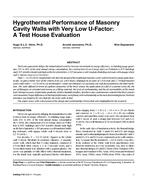Description
The Kyoto agreement obliges the industrialized world to increase investments in energy efficiency. As building usage generates 35% to 40% of the total annual energy consumption, the construction of Low Energy and Low Pollution (L2EP) buildings and L2EP retrofits should rank high on the list of priorities. L2EP presumes a well-insulated building enclosure with opaque whole wall U-factors close to 0.2 W/(m2 -K). That U = 0.2 W/(m2 -K) requirement will alter the design of the traditional masonry cavity wall in Western Europe quite drastically. To gain a better view of the criteria to be set, a test house campaign on six pairs of 1.8 m wide and 2.7 m high masonry cavity walls with U = 0.2 W/(m2 -K) as an intended U-value was initiated. For each pair, one wall faced southwest, the other northeast. The walls differed in terms of capillary properties of the brick veneer, the application of a full or a partial cavity fill, the use of fiberglass or extruded polystyrene as a filling material, the level of workmanship, and the air permeability of the inside leaf. During two years, temperature gradients, relative humidity profiles, heat flow rates, and moisture content in the brick veneers were measured. Major differences in thermal performance were found, with workmanship as the most determining factor. Moisture tolerance was found to be very high for all cavity walls tested. This paper closes with a discussion of the design and workmanship criteria that were highlighted by the research.
Authors:Hugo S.L.C. Hens, Ph.D.; Arnold Janssens, Ph.D.; Wim Depraetere
Citation: Thermal Performance of the Exterior Envelopes of Buildings VIII
Keywords:December, Florida, 2001
Citation: Thermal Performance of the Exterior Envelopes of Whole Buildings VIII
Product Details
- Published:
- 2001
- File Size:
- 1 file , 1 MB
- Product Code(s):
- D-8004




